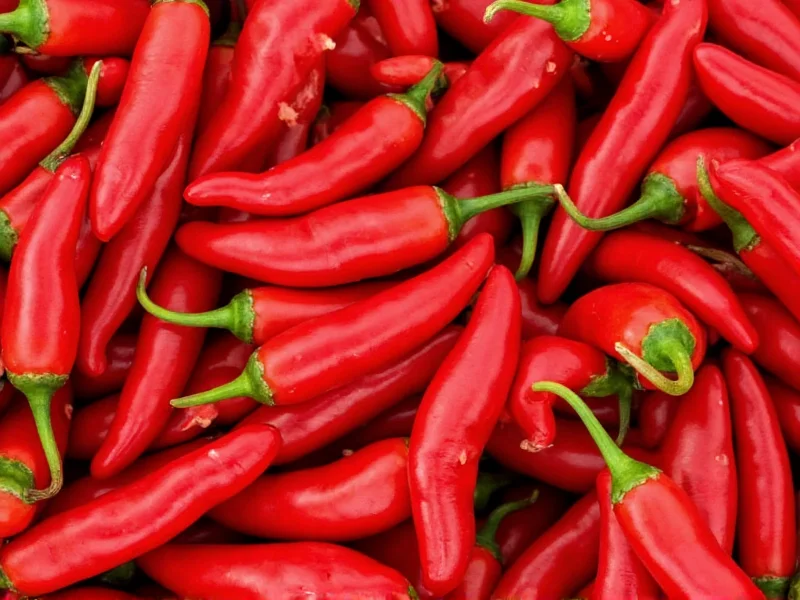When exploring the world of small red chillies, understanding their specific characteristics is essential for both safety and flavor development. These diminutive peppers pack significant heat while contributing complex flavor profiles to dishes. Unlike larger bell peppers or jalapeños, small red chillies serve primarily as heat agents rather than bulk ingredients in most culinary applications.
Common Small Red Chilli Varieties
Identifying the specific type of small red chilli you're working with prevents culinary mishaps and ensures appropriate heat management. The most frequently encountered varieties include:
| Variety | Scoville Units | Flavor Profile | Common Cuisines |
|---|---|---|---|
| Thai Bird's Eye | 50,000-100,000 | Sharp, citrusy, floral | Thai, Vietnamese, Lao |
| Piri Piri | 50,000-175,000 | Smoky, tangy, slightly sweet | Portuguese, African |
| Cayenne | 30,000-50,000 | Earthy, slightly sweet | Cajun, Creole, Indian |
| Malagueta | 60,000-100,000 | Grassy, bright, citrus notes | Brazilian, Angolan |
Heat Level Comparison and Measurement
Understanding the precise heat level of small red chillies prevents over-spicing disasters. The Scoville scale measures capsaicin concentration, with small red varieties typically falling between 30,000-175,000 units. For reference, jalapeños range from 2,500-8,000 units, making small red chillies significantly hotter.
When working with small red chillies for small red chillies identification guide purposes, consider these practical heat indicators:
- Thinner stems generally indicate higher heat levels
- Smaller size often correlates with increased capsaicin concentration
- Deep red color suggests full maturity and maximum heat development
- Shiny skin typically indicates fresher, more potent peppers
Culinary Applications and Pairing Suggestions
Mastering how to use small red chillies in cooking transforms ordinary dishes into extraordinary culinary experiences. These peppers excel in applications where concentrated heat without significant bulk is required. Professional chefs recommend these pairing strategies for optimal flavor development:
Add whole small red chillies early in cooking for infused heat with minimal spice, or finely chop and add near the end for maximum heat impact. They pair exceptionally well with coconut milk, citrus, garlic, and fish sauce in Southeast Asian cuisine. In Latin American cooking, small red chillies complement chocolate, cinnamon, and tomatoes beautifully.
When creating hot sauces using small red chillies, always wear gloves during preparation and avoid touching your face. The capsaicin oils transfer easily and can cause significant irritation to sensitive areas.
Substitution Options for Small Red Chillies
Finding suitable small red chillies substitutes becomes necessary when specific varieties aren't available. The best alternatives depend on whether you prioritize heat level or flavor profile:
- For Thai bird's eye: Use serrano peppers (less heat) or habanero (more heat with different flavor)
- For piri piri: Substitute with cayenne or crushed red pepper flakes
- For Malagueta: Try Tabasco peppers or a mix of cayenne and jalapeño
When substituting in recipes requiring small red chillies heat level comparison, remember that dried versions are typically 2-3 times hotter than fresh. Always start with half the recommended amount and adjust to taste.
Storage and Handling Best Practices
Proper storing small red chillies techniques preserves their flavor and heat for extended periods. Fresh peppers maintain quality for 2-3 weeks when stored in perforated plastic bags in the vegetable crisper. For longer storage, freeze whole peppers on a baking sheet before transferring to freezer bags—frozen small red chillies retain quality for up to 6 months.
Drying remains one of the most effective preservation methods for small red chillies. Air-dry peppers by threading them through the stems and hanging in a warm, dry area with good airflow. Properly dried peppers store indefinitely in airtight containers away from light.
Nutritional Benefits of Small Red Chillies
Small red chillies nutritional benefits extend beyond their culinary applications. These peppers contain significant amounts of vitamin C (more than oranges by weight), vitamin A, and capsaicin—the compound responsible for their heat. Regular consumption offers several health advantages:
- Metabolism boost: Capsaicin increases metabolic rate by up to 5%
- Anti-inflammatory properties: Beneficial for arthritis and joint pain
- Cardiovascular support: Helps regulate blood pressure and cholesterol
- Pain relief: Triggers endorphin release that reduces various pain types
When incorporating small red chillies into your diet, start with small amounts to assess tolerance. The health benefits accumulate with regular, moderate consumption rather than occasional large doses.
Safety Considerations When Handling Small Red Chillies
Working with small red chillies requires proper safety precautions due to their high capsaicin concentration. Always wear disposable gloves when handling these peppers, especially when cutting or seeding. Never touch your face, eyes, or sensitive areas during preparation.
If capsaicin exposure occurs, use dairy products like milk or yogurt to neutralize the burn—water spreads the oil rather than removing it. For severe reactions, consult a healthcare professional immediately. Home gardeners should label plants clearly to prevent accidental ingestion by children or pets.











 浙公网安备
33010002000092号
浙公网安备
33010002000092号 浙B2-20120091-4
浙B2-20120091-4